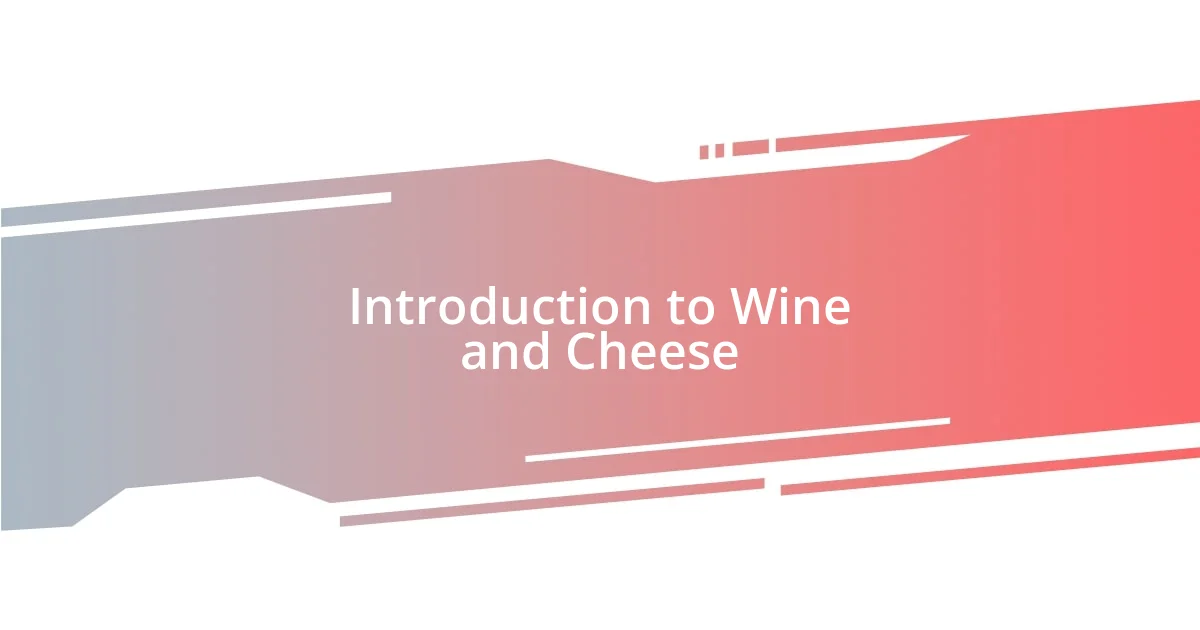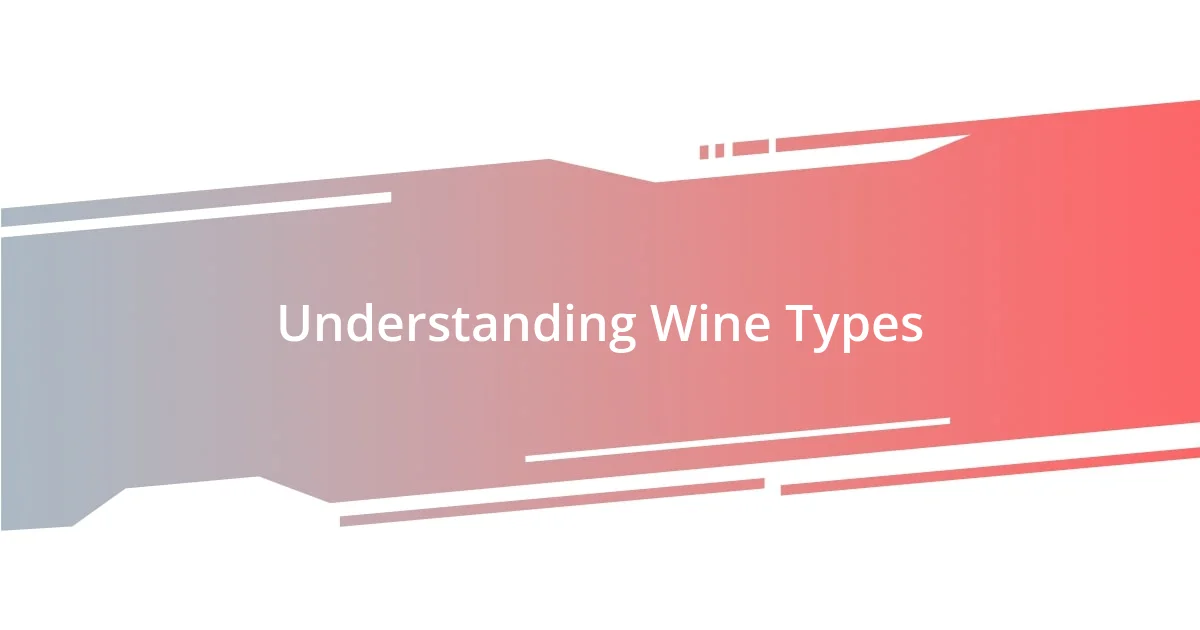Key takeaways:
- The harmony between wine and cheese is rooted in balance, with personal preferences significantly influencing pairing choices.
- Understanding wine types and cheese varieties enhances tasting experiences, leading to delightful and unexpected flavor combinations.
- Experimentation and presentation play vital roles in creating memorable gatherings, making the journey of discovering pairings enjoyable and rewarding.

Introduction to Wine and Cheese
Wine and cheese have been delightful companions for centuries, creating a sensory experience that tantalizes both the palate and the spirit. I recall my first real encounter with this pairing, sitting on a sun-drenched terrace, a crisp Sauvignon Blanc in one hand and a slice of aged cheddar in the other. The moment was not just about tasting; it felt like an exploration, a journey through flavor profiles that held their own stories.
Have you ever wondered why certain wines and cheeses harmonize so beautifully? It’s all about balance. For instance, the creaminess of Brie can soften the acidity of a bold red wine, creating a symphony of taste that dances across your taste buds. When I finally took the plunge to experiment with different pairings, I discovered not just flavors, but joy in the unexpected combinations. Each pairing invited curiosity, sparking a deeper appreciation for both the wine and the cheese.
As we delve deeper into this delicious world, it’s essential to remember that personal preferences play a significant role. Maybe you find a sharp blue cheese paired with a sweet dessert wine to be divine, while others might prefer classic combinations. I cherish the diversity in these flavors, as every tasting brings new revelations and connections—both with the food and the people I share it with.

Understanding Wine Types
Understanding the different types of wine is crucial in creating the perfect wine and cheese pairing. Each wine varietal has distinct characteristics, ranging from sweetness and acidity to body and tannin levels, which significantly affect how they complement various cheeses. I remember experimenting with a Pinot Noir at a gathering, where its fruity notes surprisingly elevated a tangy goat cheese, leading to delightful and unexpected conversations about flavor.
Here are some primary wine types to consider:
- Red Wines: Often bold and tannic, providing depth with cheeses like aged Gouda or sharp cheddar.
- White Wines: Usually crisper and lighter, they pair wonderfully with soft cheeses like Brie and fresh mozzarella.
- Rosé Wines: A refreshing blend, they bridge flavors nicely, complementing everything from feta to Gruyère.
- Sparkling Wines: Their effervescence can cut through creaminess, making them fantastic with rich cheeses like Camembert.
- Dessert Wines: Sweet and luscious, these wines can bring out the complexity in blue cheeses and creamy desserts.
Recognizing these nuances in wine types can lead to discovering mind-blowing pairings and enhancing your tasting experiences. It’s like uncovering layers in a friendship; each new discovery deepens the connection. Trust me, there’s magic in unearthing your preferences through these pairings.

Exploring Cheese Varieties
When exploring cheese varieties, I find the diversity in flavors and textures truly fascinating. For example, the contrasting profiles of a pungent blue cheese versus a mild mozzarella can be staggering. I vividly remember an evening spent with friends where a creamy Camembert balanced perfectly against a crisp Sauvignon Blanc—every bite felt like an exquisite revelation.
Each cheese brings its unique personality to the table. When I first tasted a smoky Gouda, its depth and richness opened my eyes to how interesting cheese can be. It paired so delightfully with a fruity Pinot Grigio, highlighting the nuances of both. Who knew that such different ingredients could create moments that linger in memory?
As we dive deeper into the characteristics of cheeses, let’s not forget to consider how they complement or contrast with our selected wines. Understanding these profiles allows for a more profound appreciation and could transform your next gathering into a delightful exploration of tastes.
| Cheese Type | Flavor Profile |
|---|---|
| Brie | Creamy and buttery |
| Cheddar | Sharp and nutty |
| Blue Cheese | Pungent and tangy |
| Goat Cheese | Tangy and earthy |
| Gruyère | Slightly sweet and nutty |
| Feta | Salty and crumbly |

Pairing Wine with Cheese
When it comes to pairing wine with cheese, I’ve learned that balance is key. One of my favorite combinations is a nutty aged Manchego with a robust Tempranillo. The wine’s fruitiness brings out the cheese’s complexity, creating a harmonious explosion of flavors. Can you believe how something as simple as cheese and wine can spark such joy?
I often reflect on one memorable evening when we gathered for a casual tasting session. We decided to experiment with Brie and a bold Merlot. The creamy texture of the Brie melted beautifully against the wine’s velvety tannins, producing a delightful union that had everyone raving. It reminded me that great pairings often lead to unexpected delights and lively conversations. Isn’t it amazing how food can bring people together?
Another pairing that truly surprised me was when I tried a spicy cheddar with a sweet Riesling. The contrasting flavors danced on my palate, showcasing the power of sweet-and-savory combinations. I still recall the excitement of that discovery—it’s moments like these that remind me the world of wine and cheese is full of endless possibilities, just waiting to be explored. You never know what exquisite pairing might leave a lasting impression!

Tips for Perfect Pairings
Finding the ideal cheese and wine pairing can feel a bit like an adventurous journey. I’ve always enjoyed balancing flavors, but one pairing that genuinely surprised me was pairing a tangy goat cheese with a zesty Sauvignon Blanc. The brightness of the wine accentuated the cheese’s earthiness, creating a joyous flavor symphony. Sometimes, I think about how these seemingly simple combinations can spark excitement in even the dullest gatherings.
I remember a night filled with laughter and tasting when we tried Gruyère with a smooth Chardonnay. The slightly sweet notes of the cheese harmonized with the wine’s buttery finish, and, honestly, it felt like the flavors were hugging my taste buds. Have you ever experienced a pairing that just clicked? Those moments are rare gems in the world of food and wine that I always cherish.
Don’t shy away from exploring contrasting flavors! I vividly recall pairing a sharp cheddar with a light Prosecco. The fizz of the bubbly cut through the cheese’s richness, making for an unexpected yet delightful match that left my friends buzzing with excitement. It’s fascinating how stepping outside conventional pairings can lead to discoveries that truly enhance our dining experiences.

Serving and Presentation Ideas
I’ve always found that presentation can elevate the tasting experience just as much as the pairings themselves. For a cozy evening with friends, I love using a rustic wooden board as my canvas. Arranging a colorful mix of cheeses, fruits, and nuts not only looks inviting but also invites conversation. Have you ever noticed how your guests gravitate toward a beautifully styled platter? It’s like the food speaks to them!
When I host a gathering, I often incorporate small jars of honey or fig preserves beside the cheeses. The sweetness adds another layer of flavor and creates a playful interaction between the salty and sweet. I still remember a gathering where I paired a tangy blue cheese with a honey drizzle—each bite was a delightful surprise that had everyone buzzing with excitement. Seeing the looks on my friends’ faces as they took their first taste felt incredibly rewarding.
Lighting is another crucial element to consider for ambiance. I enjoy dimming the lights and using candles to create a warm and intimate atmosphere. It’s funny how the flickering flames can set the tone for storytelling and laughter around the table. Do you think the environment affects our taste? In my experience, a charming setup truly enhances the flavors, making even the simplest combinations feel like a culinary celebration.

Conclusion and Recommendations
When it comes to choosing your wine and cheese pairings, I highly recommend trusting your own palate. Just last week, I hosted a small gathering, and I encouraged my friends to mix and match different combinations. Some of the unexpected pairings sparked lively conversations and laughter, reminding me that the joy of tasting is often found in experimentation. What pairings have you tried that surprised you?
I suggest keeping a journal of your favorite pairings as you explore different wines and cheeses. Reflecting on what worked can help you discover your personal preferences over time. I remember flipping through my old notes and realizing how certain pairings remind me of specific moments or gatherings. It’s fascinating how food can evoke memories and feelings, don’t you think?
Lastly, don’t hesitate to ask for recommendations from local cheesemongers or wine specialists. Their expertise can lead you to new and exciting combinations that might not have crossed your mind. Just recently, I learned about a stunning aged Gouda that pairs wonderfully with a rich Merlot during a chance conversation with a local expert. The world of wine and cheese is vast, and embracing the journey of discovery can be one of the most delightful parts of this culinary adventure.












